Exploring Managerial Leadership through Competing Values Framework
VerifiedAdded on 2023/06/15
|10
|1840
|214
Essay
AI Summary
This essay provides an introduction to management by analyzing the competing values framework for managerial leadership. It interprets the framework's quadrants, including the Human Relations Model, Open Systems Model, Internal Process Model, and Rational Goal Model, and assesses their impact on organizational efficiency. The application of the framework in training managers and understanding leadership roles is discussed, along with relevant theories, concepts, and competencies. The essay also explores the leadership competency framework, focusing on performance enhancement, strategic direction, and the development of a shared vision. Finally, it examines the relationship between culture, leadership, and values within the competing values framework, highlighting different leadership styles and their impact on organizational performance. Desklib provides access to this and many other solved assignments.

Running head: INTRODUCTION TO MANAGEMENT
Introduction to management
Name of student
Name of University
Author note
Introduction to management
Name of student
Name of University
Author note
Paraphrase This Document
Need a fresh take? Get an instant paraphrase of this document with our AI Paraphraser
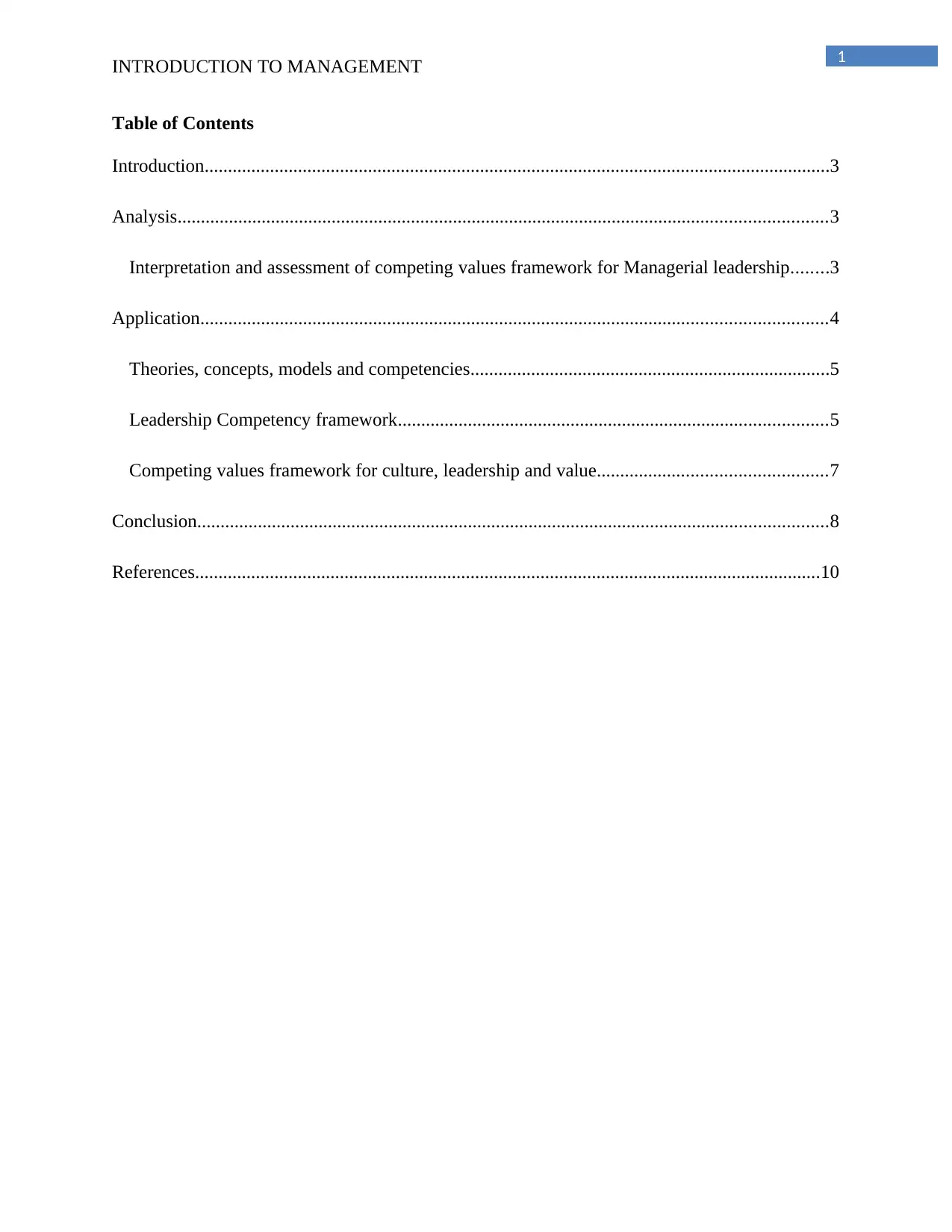
1
INTRODUCTION TO MANAGEMENT
Table of Contents
Introduction......................................................................................................................................3
Analysis...........................................................................................................................................3
Interpretation and assessment of competing values framework for Managerial leadership........3
Application......................................................................................................................................4
Theories, concepts, models and competencies.............................................................................5
Leadership Competency framework............................................................................................5
Competing values framework for culture, leadership and value.................................................7
Conclusion.......................................................................................................................................8
References......................................................................................................................................10
INTRODUCTION TO MANAGEMENT
Table of Contents
Introduction......................................................................................................................................3
Analysis...........................................................................................................................................3
Interpretation and assessment of competing values framework for Managerial leadership........3
Application......................................................................................................................................4
Theories, concepts, models and competencies.............................................................................5
Leadership Competency framework............................................................................................5
Competing values framework for culture, leadership and value.................................................7
Conclusion.......................................................................................................................................8
References......................................................................................................................................10
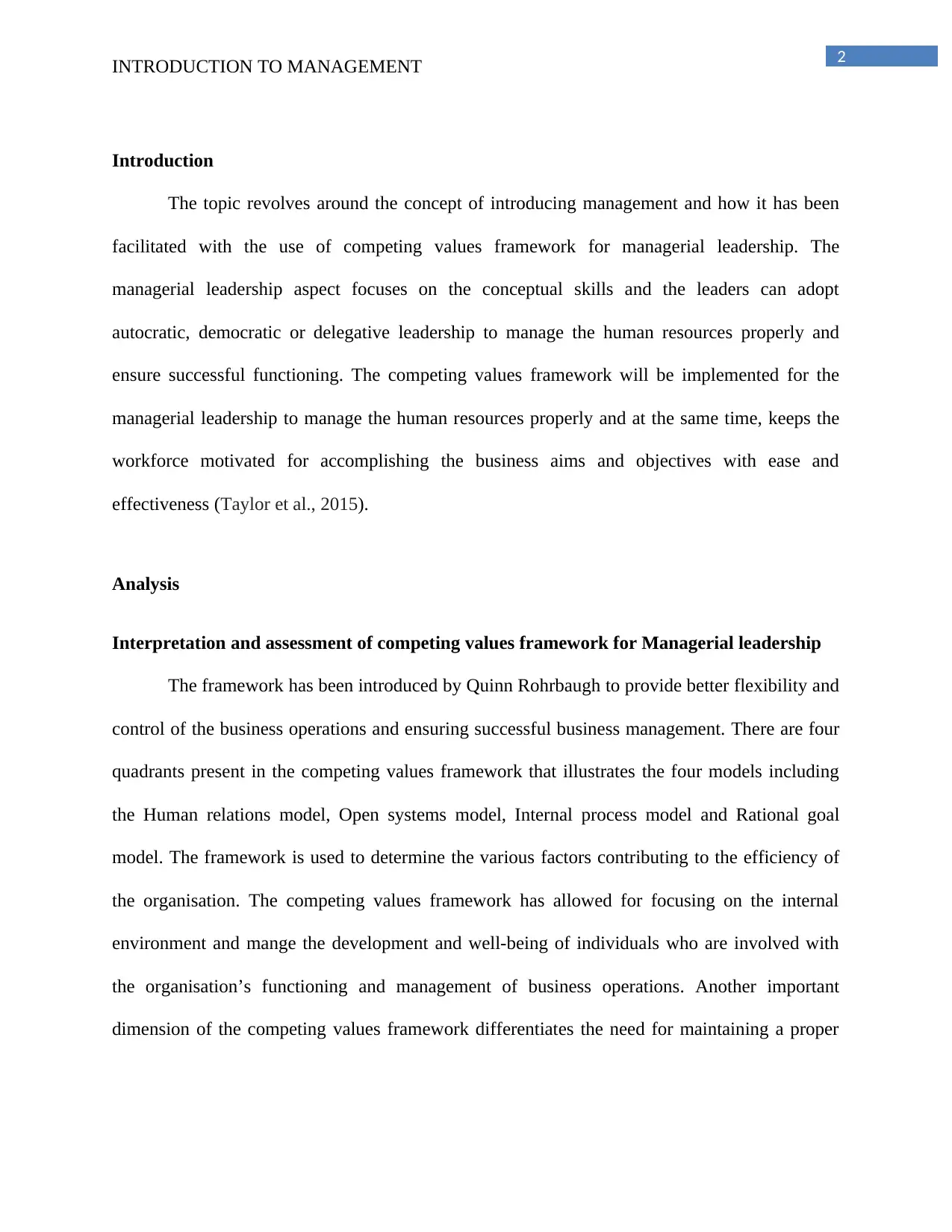
2
INTRODUCTION TO MANAGEMENT
Introduction
The topic revolves around the concept of introducing management and how it has been
facilitated with the use of competing values framework for managerial leadership. The
managerial leadership aspect focuses on the conceptual skills and the leaders can adopt
autocratic, democratic or delegative leadership to manage the human resources properly and
ensure successful functioning. The competing values framework will be implemented for the
managerial leadership to manage the human resources properly and at the same time, keeps the
workforce motivated for accomplishing the business aims and objectives with ease and
effectiveness (Taylor et al., 2015).
Analysis
Interpretation and assessment of competing values framework for Managerial leadership
The framework has been introduced by Quinn Rohrbaugh to provide better flexibility and
control of the business operations and ensuring successful business management. There are four
quadrants present in the competing values framework that illustrates the four models including
the Human relations model, Open systems model, Internal process model and Rational goal
model. The framework is used to determine the various factors contributing to the efficiency of
the organisation. The competing values framework has allowed for focusing on the internal
environment and mange the development and well-being of individuals who are involved with
the organisation’s functioning and management of business operations. Another important
dimension of the competing values framework differentiates the need for maintaining a proper
INTRODUCTION TO MANAGEMENT
Introduction
The topic revolves around the concept of introducing management and how it has been
facilitated with the use of competing values framework for managerial leadership. The
managerial leadership aspect focuses on the conceptual skills and the leaders can adopt
autocratic, democratic or delegative leadership to manage the human resources properly and
ensure successful functioning. The competing values framework will be implemented for the
managerial leadership to manage the human resources properly and at the same time, keeps the
workforce motivated for accomplishing the business aims and objectives with ease and
effectiveness (Taylor et al., 2015).
Analysis
Interpretation and assessment of competing values framework for Managerial leadership
The framework has been introduced by Quinn Rohrbaugh to provide better flexibility and
control of the business operations and ensuring successful business management. There are four
quadrants present in the competing values framework that illustrates the four models including
the Human relations model, Open systems model, Internal process model and Rational goal
model. The framework is used to determine the various factors contributing to the efficiency of
the organisation. The competing values framework has allowed for focusing on the internal
environment and mange the development and well-being of individuals who are involved with
the organisation’s functioning and management of business operations. Another important
dimension of the competing values framework differentiates the need for maintaining a proper
⊘ This is a preview!⊘
Do you want full access?
Subscribe today to unlock all pages.

Trusted by 1+ million students worldwide
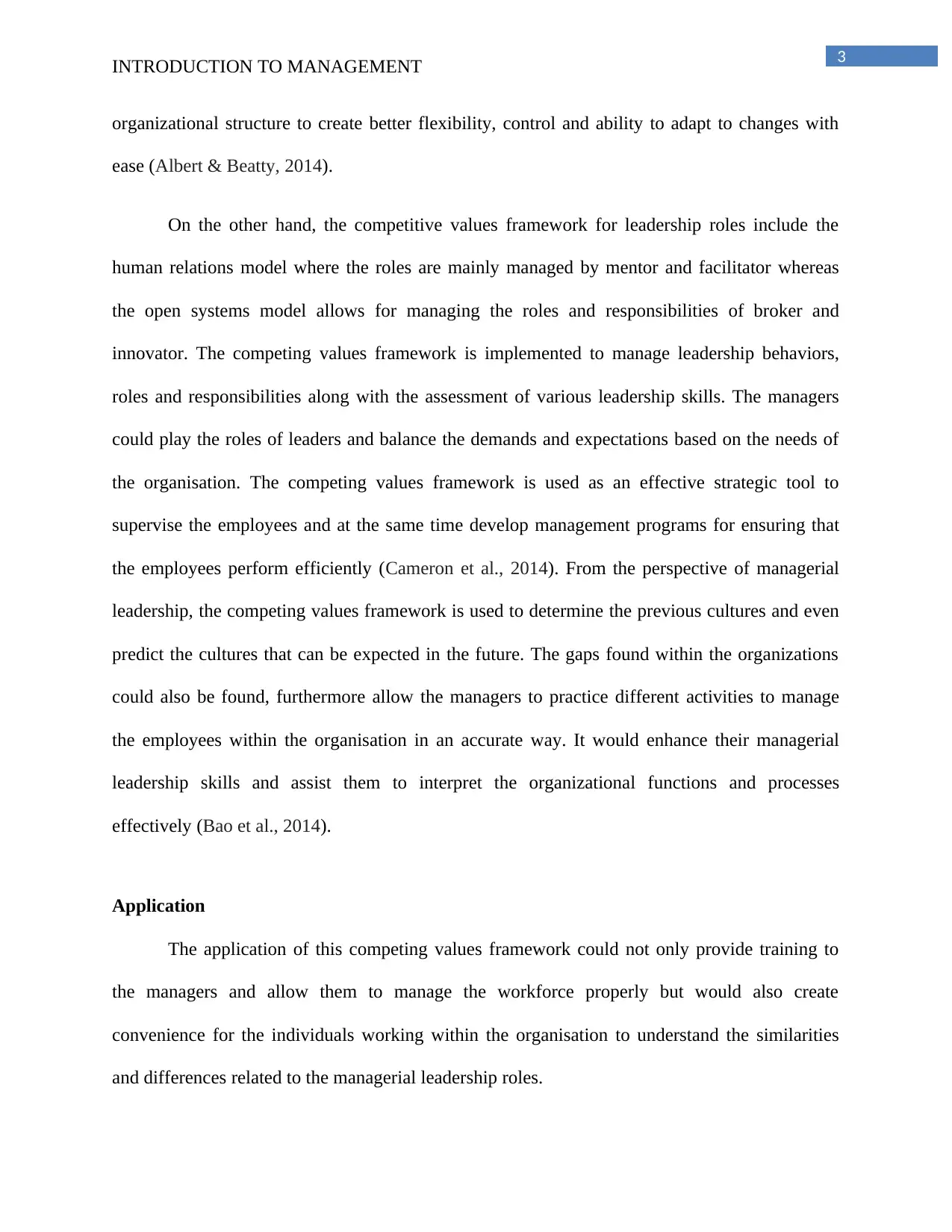
3
INTRODUCTION TO MANAGEMENT
organizational structure to create better flexibility, control and ability to adapt to changes with
ease (Albert & Beatty, 2014).
On the other hand, the competitive values framework for leadership roles include the
human relations model where the roles are mainly managed by mentor and facilitator whereas
the open systems model allows for managing the roles and responsibilities of broker and
innovator. The competing values framework is implemented to manage leadership behaviors,
roles and responsibilities along with the assessment of various leadership skills. The managers
could play the roles of leaders and balance the demands and expectations based on the needs of
the organisation. The competing values framework is used as an effective strategic tool to
supervise the employees and at the same time develop management programs for ensuring that
the employees perform efficiently (Cameron et al., 2014). From the perspective of managerial
leadership, the competing values framework is used to determine the previous cultures and even
predict the cultures that can be expected in the future. The gaps found within the organizations
could also be found, furthermore allow the managers to practice different activities to manage
the employees within the organisation in an accurate way. It would enhance their managerial
leadership skills and assist them to interpret the organizational functions and processes
effectively (Bao et al., 2014).
Application
The application of this competing values framework could not only provide training to
the managers and allow them to manage the workforce properly but would also create
convenience for the individuals working within the organisation to understand the similarities
and differences related to the managerial leadership roles.
INTRODUCTION TO MANAGEMENT
organizational structure to create better flexibility, control and ability to adapt to changes with
ease (Albert & Beatty, 2014).
On the other hand, the competitive values framework for leadership roles include the
human relations model where the roles are mainly managed by mentor and facilitator whereas
the open systems model allows for managing the roles and responsibilities of broker and
innovator. The competing values framework is implemented to manage leadership behaviors,
roles and responsibilities along with the assessment of various leadership skills. The managers
could play the roles of leaders and balance the demands and expectations based on the needs of
the organisation. The competing values framework is used as an effective strategic tool to
supervise the employees and at the same time develop management programs for ensuring that
the employees perform efficiently (Cameron et al., 2014). From the perspective of managerial
leadership, the competing values framework is used to determine the previous cultures and even
predict the cultures that can be expected in the future. The gaps found within the organizations
could also be found, furthermore allow the managers to practice different activities to manage
the employees within the organisation in an accurate way. It would enhance their managerial
leadership skills and assist them to interpret the organizational functions and processes
effectively (Bao et al., 2014).
Application
The application of this competing values framework could not only provide training to
the managers and allow them to manage the workforce properly but would also create
convenience for the individuals working within the organisation to understand the similarities
and differences related to the managerial leadership roles.
Paraphrase This Document
Need a fresh take? Get an instant paraphrase of this document with our AI Paraphraser
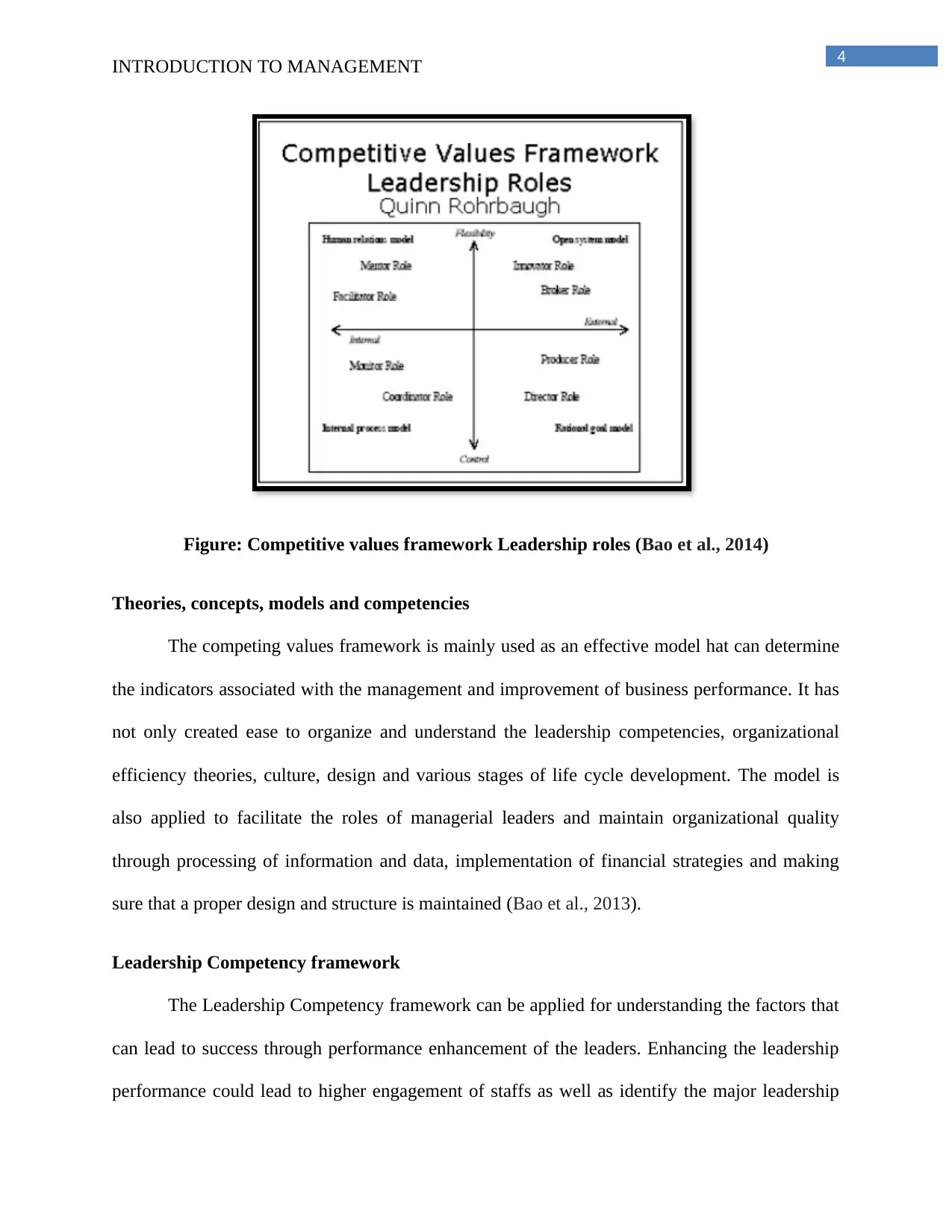
4
INTRODUCTION TO MANAGEMENT
Figure: Competitive values framework Leadership roles (Bao et al., 2014)
Theories, concepts, models and competencies
The competing values framework is mainly used as an effective model hat can determine
the indicators associated with the management and improvement of business performance. It has
not only created ease to organize and understand the leadership competencies, organizational
efficiency theories, culture, design and various stages of life cycle development. The model is
also applied to facilitate the roles of managerial leaders and maintain organizational quality
through processing of information and data, implementation of financial strategies and making
sure that a proper design and structure is maintained (Bao et al., 2013).
Leadership Competency framework
The Leadership Competency framework can be applied for understanding the factors that
can lead to success through performance enhancement of the leaders. Enhancing the leadership
performance could lead to higher engagement of staffs as well as identify the major leadership
INTRODUCTION TO MANAGEMENT
Figure: Competitive values framework Leadership roles (Bao et al., 2014)
Theories, concepts, models and competencies
The competing values framework is mainly used as an effective model hat can determine
the indicators associated with the management and improvement of business performance. It has
not only created ease to organize and understand the leadership competencies, organizational
efficiency theories, culture, design and various stages of life cycle development. The model is
also applied to facilitate the roles of managerial leaders and maintain organizational quality
through processing of information and data, implementation of financial strategies and making
sure that a proper design and structure is maintained (Bao et al., 2013).
Leadership Competency framework
The Leadership Competency framework can be applied for understanding the factors that
can lead to success through performance enhancement of the leaders. Enhancing the leadership
performance could lead to higher engagement of staffs as well as identify the major leadership
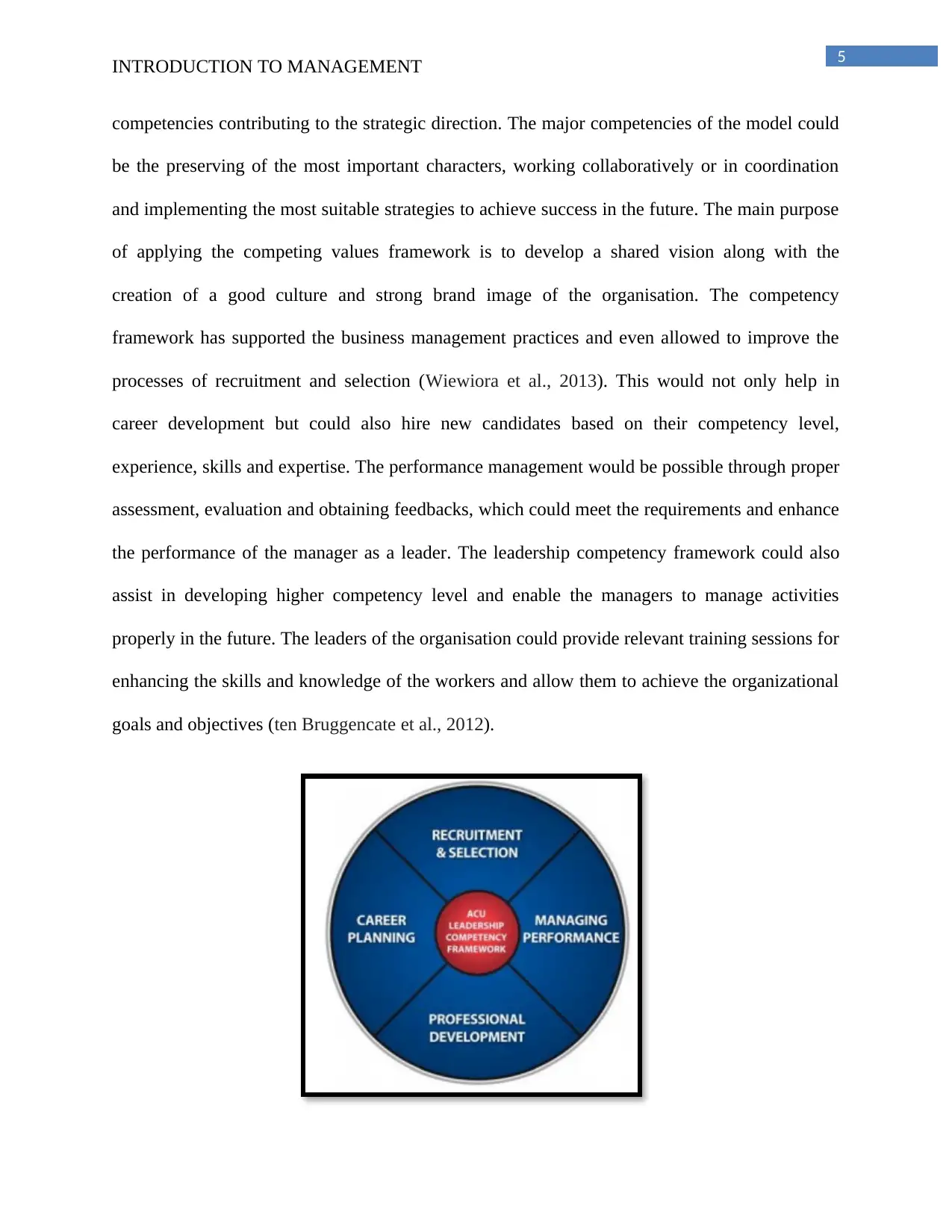
5
INTRODUCTION TO MANAGEMENT
competencies contributing to the strategic direction. The major competencies of the model could
be the preserving of the most important characters, working collaboratively or in coordination
and implementing the most suitable strategies to achieve success in the future. The main purpose
of applying the competing values framework is to develop a shared vision along with the
creation of a good culture and strong brand image of the organisation. The competency
framework has supported the business management practices and even allowed to improve the
processes of recruitment and selection (Wiewiora et al., 2013). This would not only help in
career development but could also hire new candidates based on their competency level,
experience, skills and expertise. The performance management would be possible through proper
assessment, evaluation and obtaining feedbacks, which could meet the requirements and enhance
the performance of the manager as a leader. The leadership competency framework could also
assist in developing higher competency level and enable the managers to manage activities
properly in the future. The leaders of the organisation could provide relevant training sessions for
enhancing the skills and knowledge of the workers and allow them to achieve the organizational
goals and objectives (ten Bruggencate et al., 2012).
INTRODUCTION TO MANAGEMENT
competencies contributing to the strategic direction. The major competencies of the model could
be the preserving of the most important characters, working collaboratively or in coordination
and implementing the most suitable strategies to achieve success in the future. The main purpose
of applying the competing values framework is to develop a shared vision along with the
creation of a good culture and strong brand image of the organisation. The competency
framework has supported the business management practices and even allowed to improve the
processes of recruitment and selection (Wiewiora et al., 2013). This would not only help in
career development but could also hire new candidates based on their competency level,
experience, skills and expertise. The performance management would be possible through proper
assessment, evaluation and obtaining feedbacks, which could meet the requirements and enhance
the performance of the manager as a leader. The leadership competency framework could also
assist in developing higher competency level and enable the managers to manage activities
properly in the future. The leaders of the organisation could provide relevant training sessions for
enhancing the skills and knowledge of the workers and allow them to achieve the organizational
goals and objectives (ten Bruggencate et al., 2012).
⊘ This is a preview!⊘
Do you want full access?
Subscribe today to unlock all pages.

Trusted by 1+ million students worldwide
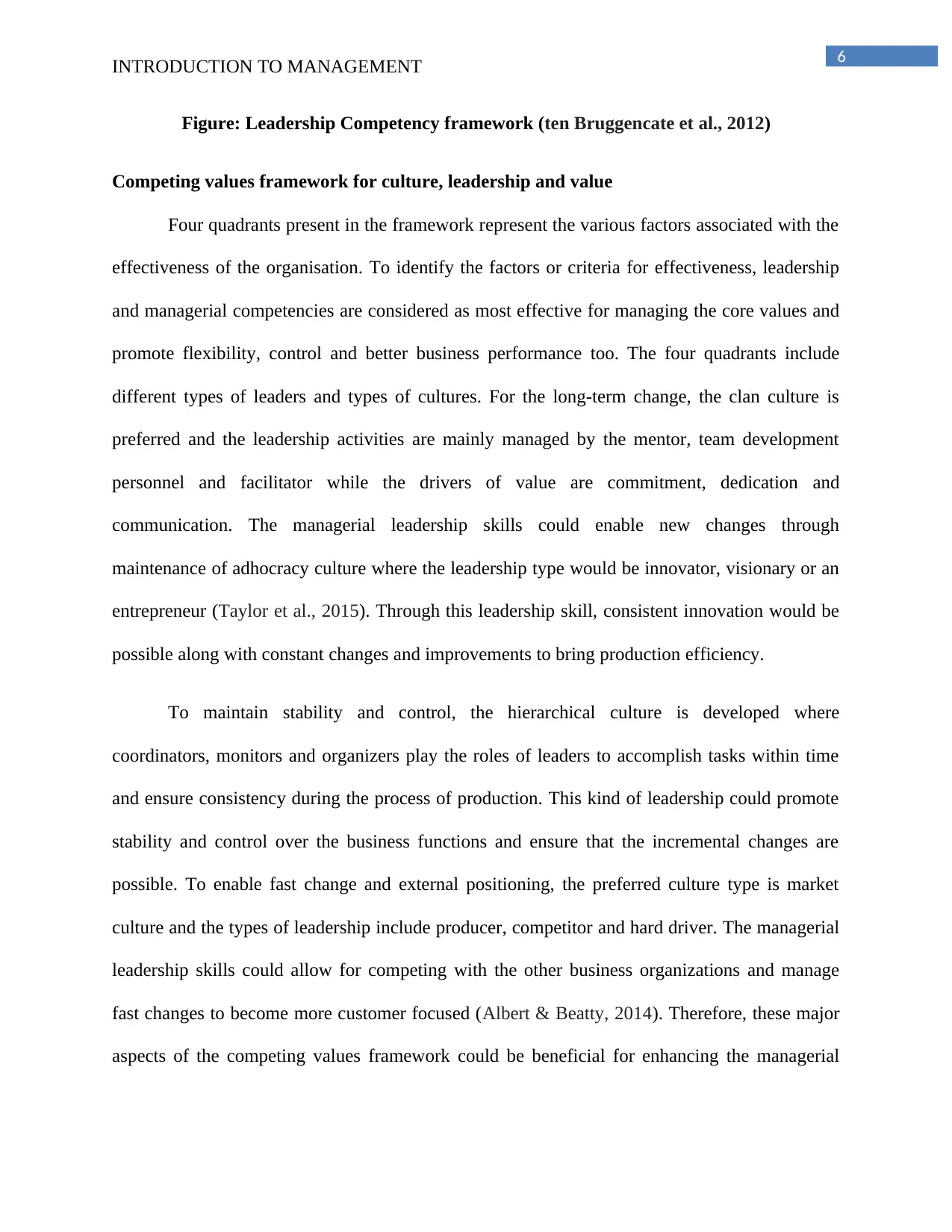
6
INTRODUCTION TO MANAGEMENT
Figure: Leadership Competency framework (ten Bruggencate et al., 2012)
Competing values framework for culture, leadership and value
Four quadrants present in the framework represent the various factors associated with the
effectiveness of the organisation. To identify the factors or criteria for effectiveness, leadership
and managerial competencies are considered as most effective for managing the core values and
promote flexibility, control and better business performance too. The four quadrants include
different types of leaders and types of cultures. For the long-term change, the clan culture is
preferred and the leadership activities are mainly managed by the mentor, team development
personnel and facilitator while the drivers of value are commitment, dedication and
communication. The managerial leadership skills could enable new changes through
maintenance of adhocracy culture where the leadership type would be innovator, visionary or an
entrepreneur (Taylor et al., 2015). Through this leadership skill, consistent innovation would be
possible along with constant changes and improvements to bring production efficiency.
To maintain stability and control, the hierarchical culture is developed where
coordinators, monitors and organizers play the roles of leaders to accomplish tasks within time
and ensure consistency during the process of production. This kind of leadership could promote
stability and control over the business functions and ensure that the incremental changes are
possible. To enable fast change and external positioning, the preferred culture type is market
culture and the types of leadership include producer, competitor and hard driver. The managerial
leadership skills could allow for competing with the other business organizations and manage
fast changes to become more customer focused (Albert & Beatty, 2014). Therefore, these major
aspects of the competing values framework could be beneficial for enhancing the managerial
INTRODUCTION TO MANAGEMENT
Figure: Leadership Competency framework (ten Bruggencate et al., 2012)
Competing values framework for culture, leadership and value
Four quadrants present in the framework represent the various factors associated with the
effectiveness of the organisation. To identify the factors or criteria for effectiveness, leadership
and managerial competencies are considered as most effective for managing the core values and
promote flexibility, control and better business performance too. The four quadrants include
different types of leaders and types of cultures. For the long-term change, the clan culture is
preferred and the leadership activities are mainly managed by the mentor, team development
personnel and facilitator while the drivers of value are commitment, dedication and
communication. The managerial leadership skills could enable new changes through
maintenance of adhocracy culture where the leadership type would be innovator, visionary or an
entrepreneur (Taylor et al., 2015). Through this leadership skill, consistent innovation would be
possible along with constant changes and improvements to bring production efficiency.
To maintain stability and control, the hierarchical culture is developed where
coordinators, monitors and organizers play the roles of leaders to accomplish tasks within time
and ensure consistency during the process of production. This kind of leadership could promote
stability and control over the business functions and ensure that the incremental changes are
possible. To enable fast change and external positioning, the preferred culture type is market
culture and the types of leadership include producer, competitor and hard driver. The managerial
leadership skills could allow for competing with the other business organizations and manage
fast changes to become more customer focused (Albert & Beatty, 2014). Therefore, these major
aspects of the competing values framework could be beneficial for enhancing the managerial
Paraphrase This Document
Need a fresh take? Get an instant paraphrase of this document with our AI Paraphraser
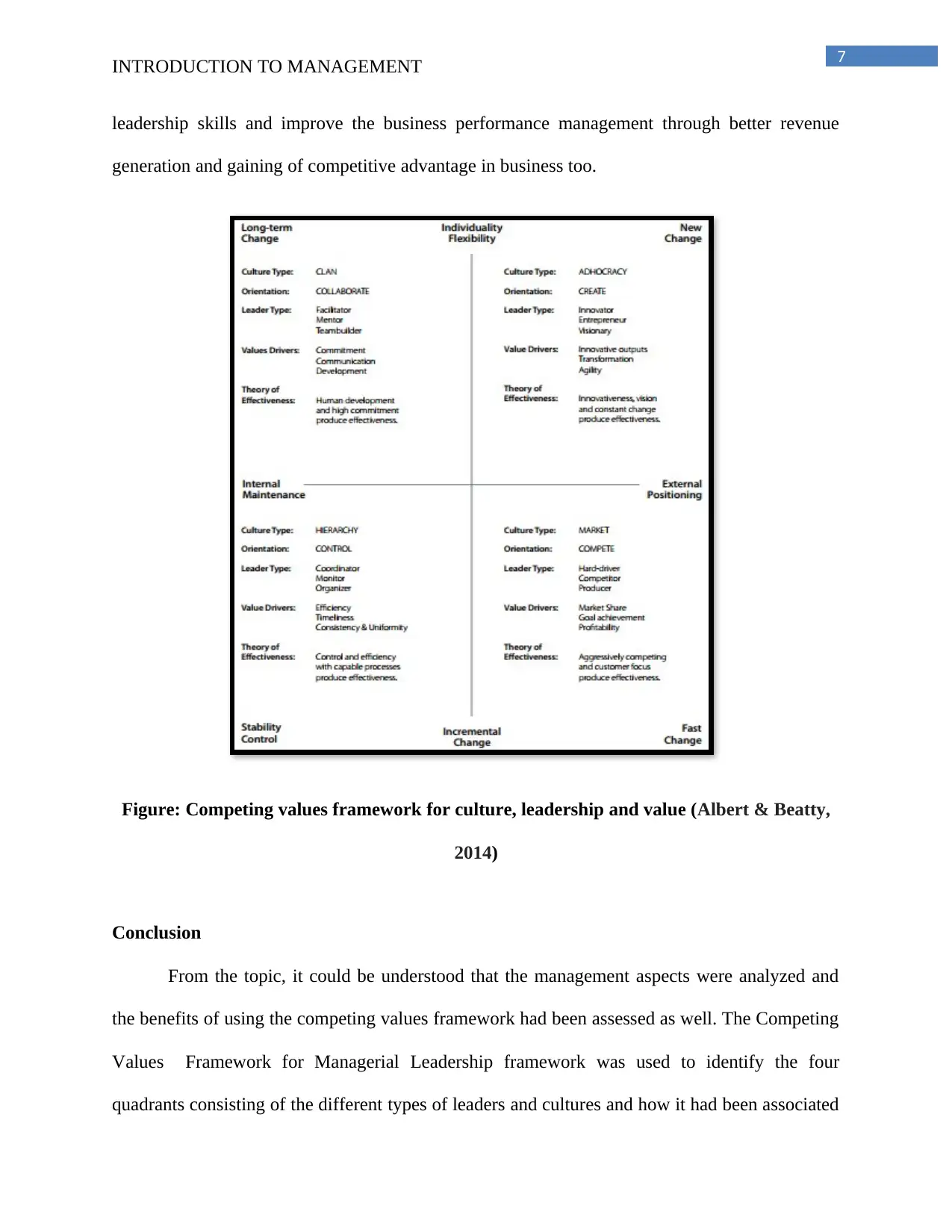
7
INTRODUCTION TO MANAGEMENT
leadership skills and improve the business performance management through better revenue
generation and gaining of competitive advantage in business too.
Figure: Competing values framework for culture, leadership and value (Albert & Beatty,
2014)
Conclusion
From the topic, it could be understood that the management aspects were analyzed and
the benefits of using the competing values framework had been assessed as well. The Competing
Values Framework for Managerial Leadership framework was used to identify the four
quadrants consisting of the different types of leaders and cultures and how it had been associated
INTRODUCTION TO MANAGEMENT
leadership skills and improve the business performance management through better revenue
generation and gaining of competitive advantage in business too.
Figure: Competing values framework for culture, leadership and value (Albert & Beatty,
2014)
Conclusion
From the topic, it could be understood that the management aspects were analyzed and
the benefits of using the competing values framework had been assessed as well. The Competing
Values Framework for Managerial Leadership framework was used to identify the four
quadrants consisting of the different types of leaders and cultures and how it had been associated
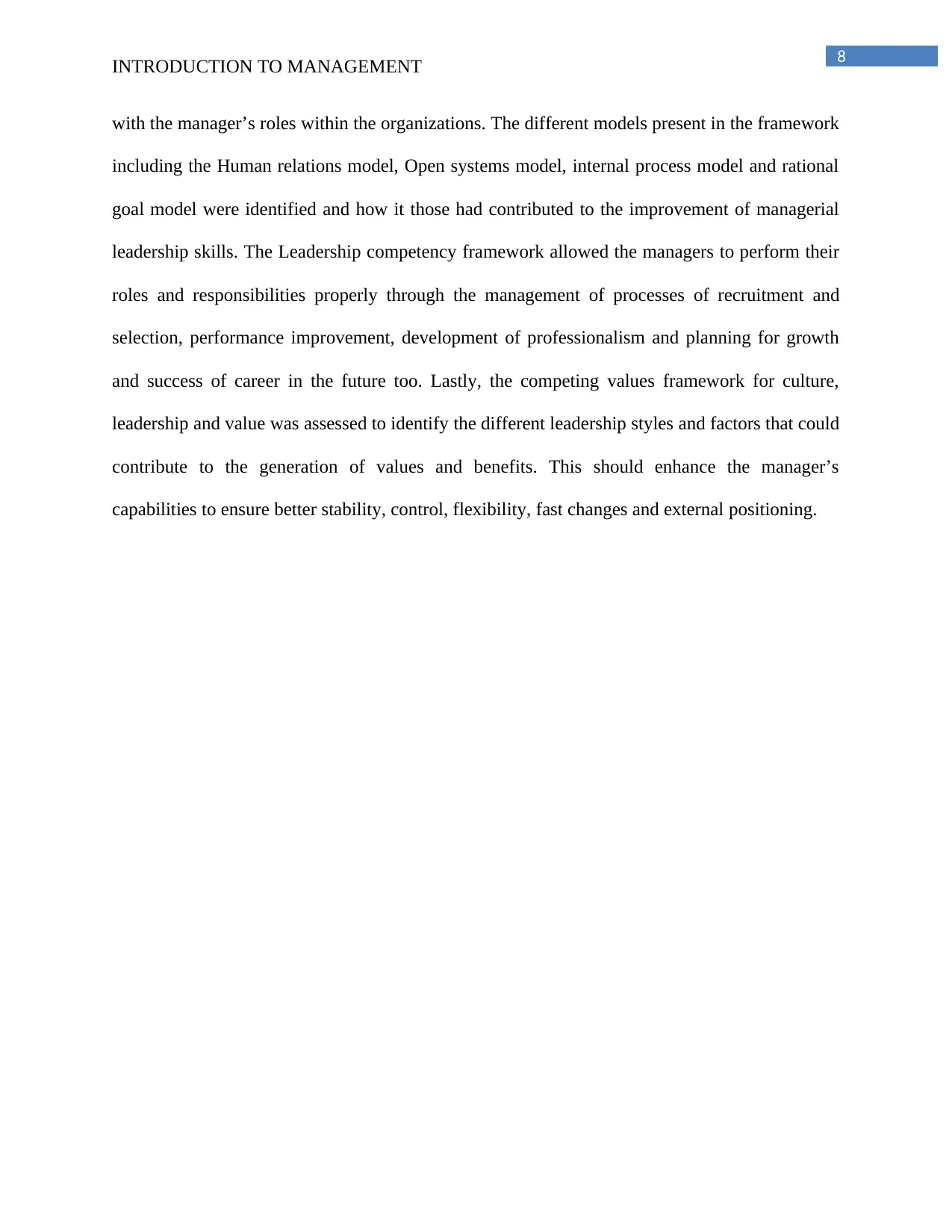
8
INTRODUCTION TO MANAGEMENT
with the manager’s roles within the organizations. The different models present in the framework
including the Human relations model, Open systems model, internal process model and rational
goal model were identified and how it those had contributed to the improvement of managerial
leadership skills. The Leadership competency framework allowed the managers to perform their
roles and responsibilities properly through the management of processes of recruitment and
selection, performance improvement, development of professionalism and planning for growth
and success of career in the future too. Lastly, the competing values framework for culture,
leadership and value was assessed to identify the different leadership styles and factors that could
contribute to the generation of values and benefits. This should enhance the manager’s
capabilities to ensure better stability, control, flexibility, fast changes and external positioning.
INTRODUCTION TO MANAGEMENT
with the manager’s roles within the organizations. The different models present in the framework
including the Human relations model, Open systems model, internal process model and rational
goal model were identified and how it those had contributed to the improvement of managerial
leadership skills. The Leadership competency framework allowed the managers to perform their
roles and responsibilities properly through the management of processes of recruitment and
selection, performance improvement, development of professionalism and planning for growth
and success of career in the future too. Lastly, the competing values framework for culture,
leadership and value was assessed to identify the different leadership styles and factors that could
contribute to the generation of values and benefits. This should enhance the manager’s
capabilities to ensure better stability, control, flexibility, fast changes and external positioning.
⊘ This is a preview!⊘
Do you want full access?
Subscribe today to unlock all pages.

Trusted by 1+ million students worldwide
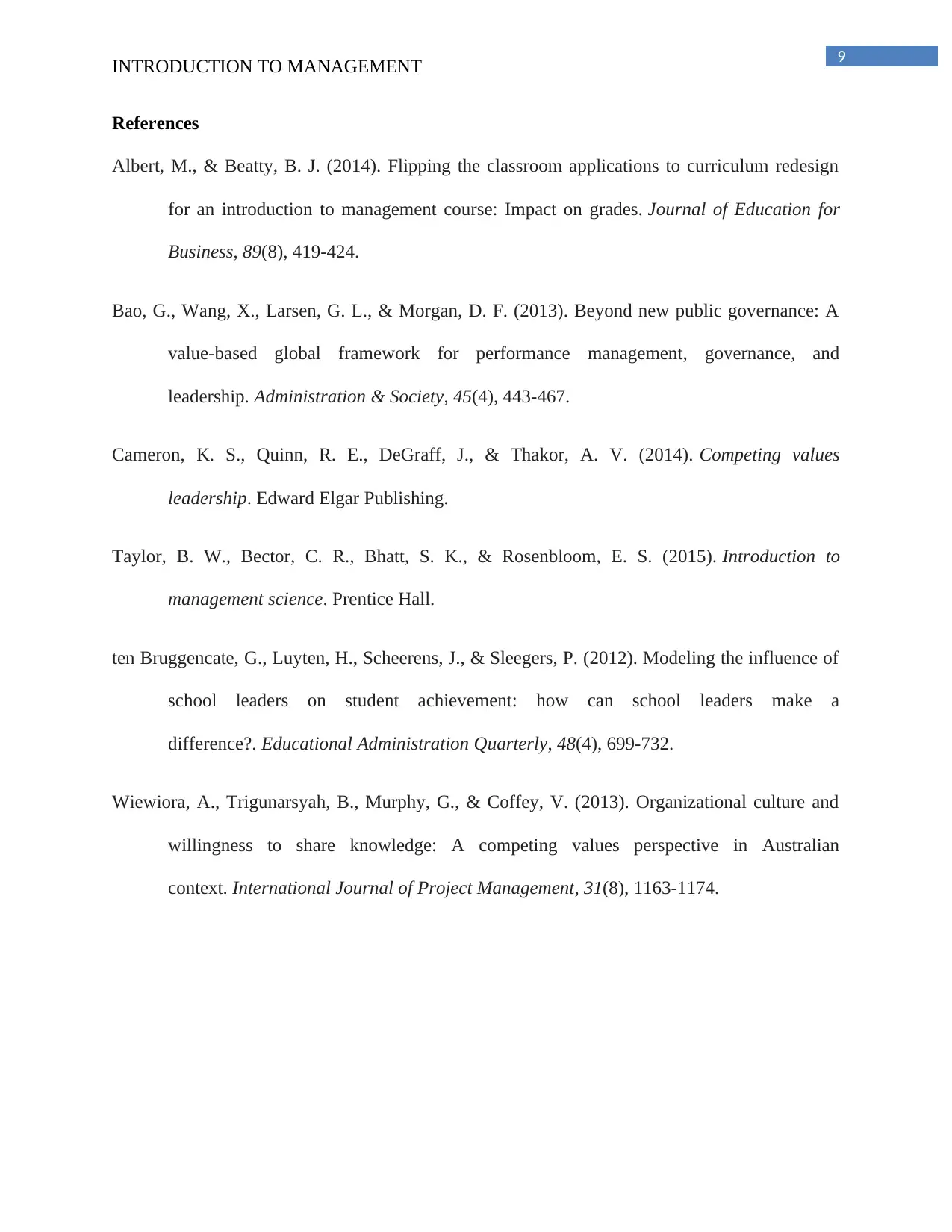
9
INTRODUCTION TO MANAGEMENT
References
Albert, M., & Beatty, B. J. (2014). Flipping the classroom applications to curriculum redesign
for an introduction to management course: Impact on grades. Journal of Education for
Business, 89(8), 419-424.
Bao, G., Wang, X., Larsen, G. L., & Morgan, D. F. (2013). Beyond new public governance: A
value-based global framework for performance management, governance, and
leadership. Administration & Society, 45(4), 443-467.
Cameron, K. S., Quinn, R. E., DeGraff, J., & Thakor, A. V. (2014). Competing values
leadership. Edward Elgar Publishing.
Taylor, B. W., Bector, C. R., Bhatt, S. K., & Rosenbloom, E. S. (2015). Introduction to
management science. Prentice Hall.
ten Bruggencate, G., Luyten, H., Scheerens, J., & Sleegers, P. (2012). Modeling the influence of
school leaders on student achievement: how can school leaders make a
difference?. Educational Administration Quarterly, 48(4), 699-732.
Wiewiora, A., Trigunarsyah, B., Murphy, G., & Coffey, V. (2013). Organizational culture and
willingness to share knowledge: A competing values perspective in Australian
context. International Journal of Project Management, 31(8), 1163-1174.
INTRODUCTION TO MANAGEMENT
References
Albert, M., & Beatty, B. J. (2014). Flipping the classroom applications to curriculum redesign
for an introduction to management course: Impact on grades. Journal of Education for
Business, 89(8), 419-424.
Bao, G., Wang, X., Larsen, G. L., & Morgan, D. F. (2013). Beyond new public governance: A
value-based global framework for performance management, governance, and
leadership. Administration & Society, 45(4), 443-467.
Cameron, K. S., Quinn, R. E., DeGraff, J., & Thakor, A. V. (2014). Competing values
leadership. Edward Elgar Publishing.
Taylor, B. W., Bector, C. R., Bhatt, S. K., & Rosenbloom, E. S. (2015). Introduction to
management science. Prentice Hall.
ten Bruggencate, G., Luyten, H., Scheerens, J., & Sleegers, P. (2012). Modeling the influence of
school leaders on student achievement: how can school leaders make a
difference?. Educational Administration Quarterly, 48(4), 699-732.
Wiewiora, A., Trigunarsyah, B., Murphy, G., & Coffey, V. (2013). Organizational culture and
willingness to share knowledge: A competing values perspective in Australian
context. International Journal of Project Management, 31(8), 1163-1174.
1 out of 10
Related Documents
Your All-in-One AI-Powered Toolkit for Academic Success.
+13062052269
info@desklib.com
Available 24*7 on WhatsApp / Email
![[object Object]](/_next/static/media/star-bottom.7253800d.svg)
Unlock your academic potential
Copyright © 2020–2025 A2Z Services. All Rights Reserved. Developed and managed by ZUCOL.





